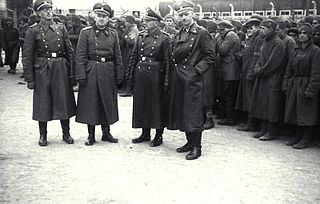
Heinrich Luitpold Himmler was Reichsführer of the Schutzstaffel, and a leading member of the Nazi Party (NSDAP) of Germany. Himmler was one of the most powerful men in Nazi Germany and a main architect of the Holocaust.

The Schutzstaffel was a major paramilitary organization under Adolf Hitler and the Nazi Party (NSDAP) in Nazi Germany, and later throughout German-occupied Europe during World War II. It began with a small guard unit known as the Saal-Schutz made up of NSDAP volunteers to provide security for party meetings in Munich. In 1925, Heinrich Himmler joined the unit, which had by then been reformed and given its final name. Under his direction (1929–1945) it grew from a small paramilitary formation during the Weimar Republic to one of the most powerful organizations in Nazi Germany. From the time of the Nazi Party’s rise to power until the regime’s collapse in 1945, the SS was the foremost agency of security, surveillance, and terror within Germany and German-occupied Europe.

The Waffen-SS was the military branch of the Nazi Party's SS organisation. Its formations included men from Nazi Germany, along with volunteers and conscripts from both occupied and unoccupied lands.

Sjögren's syndrome is a long-term autoimmune disease that affects the body's moisture-producing glands, and often seriously affects other organs systems, such as the lungs, kidneys, and nervous system. Primary symptoms are dryness, pain and fatigue. Other symptoms can include dry skin, vaginal dryness, a chronic cough, numbness in the arms and legs, feeling tired, muscle and joint pains, and thyroid problems. Those affected are also at an increased risk (5%) of lymphoma.

In German orthography, the letter, ß, called Eszett or scharfes S, represents the phoneme in Standard German, specifically when following long vowels and diphthongs, while 'ss' is used after short vowels. The name Eszett combines the names of the letters of ⟨s⟩ and ⟨z⟩ in German. The character's Unicode names in English are sharp s and eszett.

Mount Aenos or Ainos is the tallest mountain in the Ioanian island of Cephalonia, Greece, with an elevation of 1,628 metres (5,341 ft). Its bedrock is dominantly Cretaceous-era dolomite and limestone.

Dachau was a Nazi concentration camp opened on 22 March 1933, which was initially intended to hold political prisoners. It is located on the grounds of an abandoned munitions factory northeast of the medieval town of Dachau, about 16 km (10 mi) northwest of Munich in the state of Bavaria, in southern Germany. After its opening by Heinrich Himmler, its purpose was enlarged to include forced labor, and, eventually, the imprisonment of Jews, German and Austrian criminals, and finally foreign nationals from countries that Germany occupied or invaded. The Dachau camp system grew to include nearly 100 sub-camps, which were mostly work camps or Arbeitskommandos, and were located throughout southern Germany and Austria. The main camp was liberated by U.S. forces on 29 April 1945.

Obergruppenführer was one of the Third Reich's paramilitary ranks, first created in 1932 as a rank of the Sturmabteilung (SA), and adopted by the Schutzstaffel (SS) one year later. Until April 1942, it was the highest commissioned SS rank, inferior only to the Reichsführer-SS. Translated as "senior group leader", the rank of Obergruppenführer was senior to Gruppenführer. A similarly named rank of Untergruppenführer existed in the SA from 1929 to 1930 and as a title until 1933. In April 1942, the new rank of SS-Oberst-Gruppenführer was created which was above Obergruppenführer and below Reichsführer-SS.

Reichsführer-SS was a special title and rank that existed between the years of 1925 and 1945 for the commander of the Schutzstaffel (SS). Reichsführer-SS was a title from 1925 to 1933, and from 1934 to 1945 it was the highest rank of the SS. The longest serving and most noteworthy office holder was Heinrich Himmler.

SS-Totenkopfverbände was the SS organization responsible for administering the Nazi concentration camps and extermination camps for Nazi Germany, among similar duties. While the Totenkopf (skull) was the universal cap badge of the SS, the SS-TV also wore the Death's Head insignia on the right collar tab to distinguish itself from other Nazi Schutzstaffel (SS) formations.

Gundam Sentinel is a novel set in the Universal Century timeline of the Gundam universe, originally serialized in Model Graphix magazine between September 1987 and August 1988. Gundam Sentinel became a cult hit, due to its super-detailed mechanical designs and an intricate story by veteran writer Masaya Takahashi. Set between the final phase of Mobile Suit Zeta Gundam and the early stages of Gundam ZZ in UC 0088, the story shows the Earth Federation's efforts to stop an insurrection of elite Federation officers.

Epanochori is a village in the municipal unit of Omala on the island of Cephalonia, Greece. It is located 10 km east of Argostoli and 15 km west of Poros. Epanochori is located on the small road from Valsamata to Vlachata. The village sits on the westernmost part of the Aenos range.
SC 7 was the code name for a large Allied World War II convoy of 35 merchant ships and six escorts, which sailed eastbound from Sydney, Nova Scotia, for Liverpool and other United Kingdom ports on 5 October 1940. While crossing the Atlantic, the convoy was intercepted by one of the first Kriegsmarine submarine wolfpacks. During the ensuing battle, the escort was completely overwhelmed and 20 of the 35 cargo vessels were sunk and 2 more damaged, with 141 lives lost. The disastrous outcome of the convoy demonstrated the German submarines' potential of being able to work more efficiently using wolfpack tactics and the inadequacy of British anti-submarine tactics at the time.

Convoy SC 7 was the seventh of the SC convoys, bound from Sydney, Nova Scotia across the North Atlantic to a number of British ports, mainly Liverpool. They were designated SC as their departure point was designated Sydney, Cape Breton in order to avoid confusion with Sydney in Australia. The convoys formed part of the battle of the Atlantic during the Second World War. Large numbers of merchants travelled together with naval escorts to protect against U-boat attacks. They were often slow, the merchants often only being capable of a speed of around 8 knots and so were particularly vulnerable to attack. This problem was exacerbated by a shortage of suitable escorts from either the Royal Canadian Navy or the Royal Navy in the early stages of the war.

SS Aenos, formerly SS Cedar Branch, was a British-built cargo steamship. She was completed in England in 1910 and sunk in the Battle of the Atlantic in 1940.

The SS Eaglescliffe Hall was a bulk freighter initially built to serve the Canadians on the Great Lakes. She left the lakes during the Second World War to transport goods around Britain, but returned in 1959. She sank off the west Coast of Canada in 1961 after conversion to a log barge.

Aenos was a 1,935-gross register ton cargo ship that was built in 1944 as Rodenbek by Flensburger Schiffbau-Gesellschaft, Flensburg, Germany. In 1945, she was seized by the Allies at Flensburg, passed to the Ministry of War Transport (MoWT) and was renamed Empire Contyne. She was allocated to the United States in 1946 and sold into merchant service in 1948. In 1952, she was sold to Panama and renamed Aenos. In 1963, she was sold to Liberia and renamed Marlin, serving until 1965 when she foundered after her cargo shifted off North Carolina.















